Results 6,841 to 6,850 of 12091
Thread: Anandtech News
-
04-07-17, 06:50 AM #6841
Anandtech: NVIDIA Announces NVIDIA Titan Xp Video Card: Fully Enabled GP102 for $1200
If you’ve followed NVIDIA’s video card launches over the last few years, then there’s a pretty clear pattern to the company’s release schedule. If the company starts things off with a cut-down Titan, as they did with the Kepler and Pascal generations, then a full-fledged Titan is sure to follow. And sure enough, with the recent launch of the GeForce GTX 1080 Ti – which effectively put the original Titan X Pascal out to pasture – NVIDIA is back again to launch their full-fledged Titan for this generation: the NVIDIA Titan Xp.
As a sort of mid-cycle replacement for the original NVIDIA Titan X (Pascal), this is a bit more of a low-key launch for the company. There’s nothing new to talk about as far as the design goes, the market positioning, etc. Instead what we have is simply a fully-enabled GP102 GPU coming to an NVIDIA prosumer card, making it the most powerful video card NVIDIA offers.
Relative to the previous (and now discontinued) Titan, things are pretty straightforward. The last 2 SMs have been enabled, and both the GPU and memory clockspeeds have seen a minor bump as well.NVIDIA GPU Specification Comparison NVIDIA Titan Xp GTX 1080 Ti NVIDIA Titan X
(Pascal)GTX Titan X
(Maxwell)CUDA Cores 3840 3584 3584 3072 Texture Units 240 224 224 192 ROPs 96 88 96 96 Core Clock 1481MHz? 1481MHz 1417MHz 1000MHz Boost Clock 1582MHz 1582MHz 1531MHz 1075MHz TFLOPs (FMA) 12.1 TFLOPs 11.3 TFLOPs 11 TFLOPs 6.1 TFLOPs Memory Clock 11.4Gbps GDDR5X 11Gbps GDDR5X 10Gbps GDDR5X 7Gbps GDDR5 Memory Bus Width 384-bit 352-bit 384-bit 384-bit VRAM 12GB 11GB 12GB 12GB FP64 1/32 1/32 1/32 1/32 FP16 (Native) 1/64 1/64 1/64 N/A INT8 4:1 4:1 4:1 N/A TDP 250W 250W 250W 250W GPU GP102 GP102 GP102 GM200 Transistor Count 12B 12B 12B 8B Die Size 471mm2 471mm2 471mm2 601mm2 Manufacturing Process TSMC 16nm TSMC 16nm TSMC 16nm TSMC 28nm Launch Date 04/06/2017 03/10/2017 08/02/2016 03/17/2015 Launch Price $1200 $699 $1200 $999
Perhaps more meaningful is to compare the Titan Xp to its only real competition on the market, the GTX 1080 Ti. What does a Titan get you over a Ti for this generation? Okay, it gets you about the same thing: the last 2 SMs are unlocked, and the memory clockspeed has seen a very small bump. However reflecting how NVIDIA opted to hobble the GTX 1080 Ti just a little bit to leave room for the inevitable Titan, NVIDIA’s prosumer card gets a bit more memory and a bit more memory bandwidth, thanks to the re-enabling of the full 384-bit memory bus.
Bringing back the last 32-bit memory channel and its associated GDDR5X chip gives the Titan Xp a total of 547.2GB/sec of memory bandwidth, 13% more than its lower-tier sibling. Otherwise on the GPU performance front, we’re looking at 7% more shader/texture/geometry throughput and 9% more ROP throughput. Or to compare it the last-generation flagship GTX Titan X (Maxwell), from flagship-to-flagship NVIDIA has improved GPU performance by 84%, ROP throughput by 47%, and memory bandwidth by 63%.
As for power and other design considerations, this hasn’t changed. The Titan Xp is still a 250W card, and it’s still designed like the last Titan X, clad in black with NVIDIA’s current-generation heatsink and shroud design. Simply put, if you’re a regular NVIDIA high-end customer, then NVIDIA has made it very easy to pull out your GTX 780Ti/980Ti/Titan and replace it with the new Titan Xp.
However before we get off of the specifications entirely, there’s one aspect of the new Titan Xp that surprises me: the memory capacity. In the previous generations, Titan cards have offered the full memory capacity for their associated GPU, equivalent to NVIDIA’s Tesla and Quadro cards. For the original Titan, this was 6GB, and 12GB for the Titan X (Maxwell). However with the Titan Xp, NVIDIA is still only offering 12GB of VRAM, while the otherwise equivalent Quadro P6000 gets 24GB. This is an interesting departure from the norm for the company.
I have a couple of ideas on why this is, though it’s all speculation. The first is that this is a market reason: NVIDIA needs to enforce better market segmentation between the prosumer Titan and the professional Tesla. Typically this is done via their respective driver sets and what features these cards offer (Tesla not being rigged for workstations, for example). However Titan X (Maxwell) was very popular in the previous generation, and it may be that it did a little too well compared to the Tesla, and NVIDA is concerned that there will be a repeat performance here even though they’ve done a much greater level of feature separation via the differences in the GP100 and GP102 GPUs.
The other theory is that NVIDIA can’t have it all – they can’t both have super-fast GDDR5X, and 24GB of it in clamshell mode at the same time. It’s telling on the memory bandwidth front that NVIDIA has overclocked the Titan Xp’s memory just a bit; 11.4Gbps, even though partner Micron’s GDDR5X tops out at 11Gbps. Granted, 12Gbps is coming, but I think Micron would be announcing that and NVIDIA would just run with 12Gbps. In any case, this compares starkly to the Quadro P6000, which does get 24GB of VRAM, but with its GDDR5X underclocked to 9Gbps. Or to take it one step further, the Tesla P40, which doesn’t get GDDR5X at all and only has GDDR5. NVIDIA and Micron have definitely pushed the envelope with GDDR5X, so given the additional complexities of clamshell mode, it’s not unreasonable to speculate that a 12GB card is for technical reasons along these lines.
In any case, NVIDIA’s handling of the Titan Xp and their intended market hasn’t changed from the previous generation Titan. This means NVIDIA is walking an interesting line with partners and customers in positioning this as a prosumer card. At $1200 it’s 71% more expensive than the GTX Titan Ti, all for one last GB of memory and 5-10% more performance. That last bit of flagship performance from NVIDIA has always come at a price, and the Titan Xp is no exception.
The expected customer base then is both professionals and consumers, however one that leans more strongly towards professionals than the Maxwell generation. Professionals would just as well work with NVIDIA directly, whereas consumers have (and generally still do) work via NVIDIA’s partners, whom of course won’t be promoting the Titan Xp since they don’t get to sell it. Which is not to say that you can’t buy it and game on it – for those whom money is no object, this will happen – and it’s even conveniently on the GeForce website. But even then, the NVIDIA Titan Xp (remember, this isn’t a GeForce) doesn’t get the same level of promotion with consumers and gamers as past iterations have. The prosumer card is decidedly more professional, especially with the almost-as-good GeForce GTX 1080 Ti right below it.
Meanwhile, on a personal note, I’m entirely nonplussed with the name. NVIDIA named the previous Titan X (Pascal) poorly, and they seem content to continue that trend here. Because the previous Pascal-based Titan was called the “Titan X”, it’s very common to see it informally referred to as the “Titan XP”. Except now we have NVIDIA selling the “Titan Xp”, which is not the same card as the “Titan XP”. I appreciate NVIDIA at least not calling this the “Titan X” yet again – and I assume that all of this started from someone wanting to call it the “Titan X Plus” but they really need to find better names. My suggestion: either pick unique Titan names, or at least go with yearly model numbers like cars and iPads.
Anyhow, for those whose wallets are deep enough to buy NVIDIA’s latest prosumer and budget deep-learning card, the card will set you back $1200. Like the previous Titan, the NVIDA Titan Xp is being sold exclusively through NVIDIA’s website, and has already gone on sale today.
More...
-
04-07-17, 08:30 AM #6842
Anandtech: The Seasonic PRIME Titanium PSU (650W, 750W, 850W) Review: Mythical Perfor
In this review we are having a look at Seasonic’s new flagship series, the PRIME Titanium 650W, 750W and 850W PSUs. These three units are 80Plus Titanium certified, come with a 12-year warranty, and even then we were stunned to see the almost mythical results.
More...
-
04-07-17, 11:19 PM #6843
Anandtech: Chuwi Announces The LapBook 12.3 With 3:2 267 PPI Display
Chuwi is a relatively unknown company in the PC space, but only about a month ago we took a look at the Chuwi LapBook 14.1, and came away very impressed. They are shaking up the low-cost segment of the PC market with some low cost, but well featured devices. The LapBook 14.1, for instance, ships with a 1920x1080 IPS display, 4 GB of RAM, and 64 GB of storage, all for less than $300 USD. Normally when you see notebooks around these price points, they come with several serious compromises which really detract from the experience, but the LapBook 14.1 made some great trade-offs to offer a good machine for a low price.
Today Chuwi reached out with some news that they are going to be releasing the LapBook 12.3 at the end of April. It features the same CPU as the LapBook 14.1, with an Intel Celeron N3450, which is a quad-core Apollo Lake. Performance is not as good as a Core based laptop, but the experience is reasonable for less demanding tasks. Chuwi is pairing this with 6 GB of RAM, and 64 GB of eMMC flash storage, so the experience should be similar to the LapBook 14.1, but with more RAM so you can multitask a bit more. They are also keeping the 802.11ac Wi-Fi, which is probably the same 1x1 card found in the larger LapBook.
Probably the most interesting part of the LapBook 12.3 is that it is shipping with a 2736x1824 3:2 display at 12.3-inches. That gives a density of 267 pixels per inch, and eagle-eyed readers might have noticed that this is the same resolution and size as the display in the Surface Pro 4, so it is likely the same panel that Microsoft is using in their tablet. Chuwi didn’t confirm if it was an IPS display, but it most likely is. It's similar to their Hi 13 2-in-1 which uses a 3000x2000 13.5-inch display, so they are clearly using Microsoft's influence to source components which is great to see.
The new LapBook 12.3 measures in at 300 x 223 x 16.7 mm (11.8 x 8.78 x 0.66 inches), and weighs in at 1.45 kg (3.18 lbs), so despite the small and thin design, it’s not as light as a more expensive Ultrabook would be at this size.Chuwi LapBook 12.3 CPU Intel Celeron N3450
4C/4T
1.1-2.2 GHz
2MB L2 Cache
6W TDPGPU Intel HD Graphics 500
12 Execution Units (Gen 9)
200-700 MHzMemory 6 GB Dual-Channel Display 12.3" 2736x1824 3:2 Aspect Ratio Storage 64 GB eMMC Dimensions 300 x 223 x 16.7 mm
11.8 x 8.78 x 0.66 inchesWeight 1.45 kg / 3.18 lbs Wireless 802.11ac Launch April 30, 2017 Price TBD
Chuwi hasn’t announced pricing yet, but considering the rest of their lineup, it should be very competitive.
Look for the LapBook 12.3 when it launches at the end of April.
Source: Chuwi
More...
-
04-10-17, 06:51 AM #6844
Anandtech: Xiaomi Mi MIX: A Closer Look at the Design and Display
Xiaomi’s Mi MIX gives us a glimpse of the future. A pseudo-concept phone that’s being produced in limited quantities and sold in China, it combines the latest technology with innovative design, resulting in a forward-looking phone with virtually no bezels on three sides of the screen and an amazing 91.3% screen-to-body ratio.
More...
-
04-10-17, 08:06 AM #6845
Anandtech: ADATA Announces The XPG SX7000 Series SSDs: Up to 1 TB, M.2, PCIe 3.0 x4
ADATA has announced its new lineup of SSDs designed to combine high-performance with 3D TLC flash memory. The new XPG SX7000 is positioned below ADATA’s flagship XPG SX8000 series, but for those looking for something more powerful than a typical SATA drive, but not ready to invest in a super high-end SSD, this is the market ADATA is aiming for.
The ADATA XPG SX7000 series lineup comes in an M.2-2280 form-factor, uses PCIe 3.0 x4 and features 128 GB, 256 GB, 512 GB as well as 1 TB capacities. Worth noting, however, that traditionally for ADATA the highest-capacity drives will be available at a later date. Just like the higher-end XPG SX8000, the new SSDs are powered by Silicon Motion’s SM2260 controller but has 3D TLC NAND (presumably from Micron).
The SM2260 is a controller we're starting to see a lot more of - as a controller it has two ARM Cortex cores, features eight NAND flash channels, LDPC ECC technology, 256-bit AES support and so on, although different drives may have different features enabled/disabled.
From a performance point of view, the ADATA XPG SX7000 drives are very different from each other due to the level of parallelism afforded by the controller/NAND combinations. For the 512 GB version, it is rated for sequential read speed up to 1750 MB/s as well as for sequential write speed up to 860 MB/s when pseudo-SLC caching is used. As for random performance, the 512 GB drive can offer up to 130K/140K 4 KB read/write IOPS. When it comes to the XPG SX7000 128 GB, the lowest capacity of the set, we are dealing with a drive capable of up to 660/450 MB/s sequential read/write performance as well as 35K/95K read/write IOPS. The drive is slightly faster than SATA SSDs based on TLC NAND, but it should offer higher endurance because 3D TLC NAND is made using larger process technologies and can account for voltage drift better.
Speaking of endurance, the XPG SX7000 come with a five-year limited warranty and are rated for 2 million hours MTBF. As for the TBW rating, the 128 GB SSD is rated for 80 TB, whereas the 512 GB version is capable of 320 TBW, which equals to around 0.3 DWPD (drive writes per day) across the warranty lifetime.
The ADATA XPG SX7000 SSDs are expected to hit the shelves in the coming weeks. Micron’s 3D TLC memory has been in mass production for several quarters now and ADATA has offered SATA drives featuring this memory for several months. As a result, the supply of 3D TLC NAND is not going to be a problem. As for pricing, expect the XPG SX7000-series to be cheaper compared to the higher-end XPG SX8000.ADATA XPG SX7000 Specifications Capacity 128 GB 256 GB 512 GB 1 TB Model Number ASX7000NP-
128GT-CASX7000NP-
256GT-CASX7000NP-
512GT-Cunknown Controller Silicon Motion SM2260 NAND Flash 3D TLC NAND Form-Factor, Interface M.2-2280, PCIe 3.0 x4, NVMe 1.2 Sequential Read 660 MB/s 1370 MB/s 1750 MB/s unknown Sequential Write 450 MB/s 820 MB/s 860 MB/s unknown Random Read IOPS 35K IOPS 70K IOPS 130K IOPS unknown Random Write IOPS 95K IOPS 130K IOPS 140K IOPS unknown Pseudo-SLC Caching Supported DRAM Buffer Yes, capacity unknown TCG Opal Encryption No Power Management DevSleep, Slumber Warranty 5 years MTBF 2,000,000 hours MSRP Unknown Unknown Unknown Unknown
Related Reading:
- ADATA Launches XPG SX8000: High-End M.2 NVMe SSD Featuring 3D MLC NAND
- ADATA Launches the SU700 SSD Range: Maxiotek MK8115, 3D TLC, Up to 960 GB
- Previewing Silicon Motion SM2260 NVMe Controller With 3D MLC NAND (512GB)
- ADATA Introduces Ultimate SU800 SSD: SMI Controller, 3D NAND, SATA Interface
- ADATA Ultimate SU800 SSDs in M.2 Announced: Entry-Level 3D NAND SSDs for Laptops
- ADATA Announces Ultimate SU900: 3D MLC NAND, SMI Controller, SATA
More...
-
04-10-17, 10:43 AM #6846
Anandtech: G.Skill Announces Trident Z RGB DDR4 Kits with 16 GB Modules, Up to 128 GB
G.Skill has recently launched new Trident Z RGB memory kits, this time aimed at Intel X99 platforms, and following the RGB trend they give owners of high-end desktops an opportunity to customize the look of DRAM inside their machines. This is also the launch where the company introduces its first 16 GB memory modules with programmable LED lighting.
The Trident Z RGB memory modules feature programmable LED lightbars and can change their colors in accordance with user’s demands (G.Skill offers special software to customize lighting effects), providing the ability to modify the look of a PC on the fly. G.Skill first announced its Trident Z RGB memory modules in late 2016 and started to sell them early in 2017. Initially, G.Skill’s Trident Z RGB dual-channel kits were only focused on Intel’s Z270-based platforms and contained 8 GB DIMMs running at up to DDR4-3866 MT/s. Going forward, G.Skill will offer 16 GB Trident Z RGB modules in both dual-channel and quad-channel kits.
Just like the Trident Z RGB 8 GB modules, the Trident Z RGB 16 GB DIMMs are based on Samsung’s 8 Gb B-die memory chips made using 20 nm process technology. The 16 GB modules will run at DDR4-2400 to DDR4-3866 with CL14-18 latencies at 1.2 V or 1.35 V, depending on the kit performance. The Trident Z RGB fully support Intel’s XMP 2.0 as well.
G.Skill’s fastest dual-channel Trident Z RGB 32 GB (2×16 GB) kit will run at 3866 MT/s with CL18 18-18-38 timings. RGB commands a premium, so while the company’s fastest DDR4 kits (rated for DDR4-4266) are not RGB, the new modules are still a very high data rate for 16 GB modules. As for the fastest quad-channel kits, G.Skill now offers the Trident Z RGB 64 GB (4×16 GB) rated to operate at 3600 MT/s with CL17 19-19-39 latency settings as well as the Trident Z RGB 128 GB (8×16 GB) DDR4-3333 kit with CL16 18-18-38 timings.
*1.35V is the standard high-performance voltage setting for DDR4G.Skill's New Trident Z RGB Memory for Intel's X99 and Z270 Platforms Speed CL Timing Voltage Kit Configuration Kit Capacity DDR4-2400 CL15 15-15-35 1.2 V 2×16 GB
4×16 GB
8×16 GB
8×8 GB32 GB
64 GB
128 GB
64 GBDDR4-3000 CL14 14-14-34 1.35 V* DDR4-3200 CL14 14-14-34 CL15 15-15-35 DDR4-3333 CL16 18-18-38 8×16 GB
8×8 GB128 GB
64 GBDDR4-3466 CL16 18-18-38 2×16 GB
4×16 GB
8×8 GB32 GB
64 GB
64 GBDDR4-3600 CL17 19-19-39 2×16 GB
4×16 GB32 GB
64 GBDDR4-3866 CL18 18-18-38 2×16 GB 32 GB
While these kits are aimed at Intel systems, we would assume that qualification on Ryzen systems will be an ongoing process. G.Skill has just sent us a 2x8GB DDR4-3200 C14 kit of G.Skill FlareX (non-RGB) modules for our Ryzen testing, so it's clear that G.Skill (and others) will have AMD qualified kits in their roadmaps. Motherboard manufacturers typically have memory qualified validation lists on their websites for each motherboard, showing which modules have been confirmed to work. Initially it was hit and miss on DRAM qualification with the launch of Ryzen 7 due to timing, but most vendors are falling into place with appropriate BIOS updates.
G.Skill traditionally does not announce MSRPs for its memory modules, due to the volatility of the DRAM ICs, but given the fact that DRAM pricing is generally increasing, expect the new Trident Z RGB kits to be priced at high levels. Moreover, since it is not easy to handpick 8 Gb chips for high-speed 16 GB DDR4 memory modules, expect the manufacturer to charge a premium for kits that use high-capacity DIMMs. As an example, right now G.Skill offers 32 GB (4×8 GB) DDR4-3600 and DDR4-3866 kits without RGB for $410 and $460, respectively.
Gallery: G.Skill Announces Trident Z RGB Kits for Intel X99, Adds 16 GB Modules to Family





Related Reading:
- Corsair Vengeance RGB DDR4 Memory Modules with LEDs Now on Sale
- G.Skill Announces Trident Z DDR4 DIMMs for Kaby Lake CPUs
- G.Skill Announces Trident Z RGB Illumination to DDR4
- G.Skill Shows Off Trident Z 8x8 GB and 8x16 DDR4-3333 Memory Kits
More...
-
04-10-17, 01:25 PM #6847
Anandtech: Toshiba Launches MG05ACA Enterprise HDDs: 8 TB, 7200 RPM, NAND Cache
Toshiba recently introduced its new generation of enterprise-class nearline HDDs for servers, surveillance, and higher-end NAS systems. The new MG05ACA-series hard drives offer up to 8 TB of capacity and 12% higher performance than their direct predecessors, but one of their key selling points is Toshiba’s NAND flash-based cache technology for data protection in case of power-loss events that was originally designed for mission-critical HDDs.
Toshiba’s MG05ACA-series HDDs are currently available only in 8 TB configurations and are based on multiple PMR (perpendicular magnetic recording) platters with either 4Kn or 512e sectors. The hard drives use a SATA 6 Gbps interface, feature a 7200 RPM spindle speed, a 128 MB cache buffer, and Toshiba’s persistent write cache (PWC) with power loss protection (PLP) that stores data that is not yet written to the HDD media. When it comes to performance, Toshiba declares up to 230 MB/s sustained host to media transfer speed as well as 4.17 ms average latency. As for power consumption, the MG05ACA-series hard drives are rated to consume up to 11.4 W during random reads and 6.2 W in active idle mode.
The Toshiba MG05-series HDDs are designed for nearline applications (i.e. somewhere between rapid access and cold storage) that operate for 24/7. The model is rated for 550 TB/year annual workload (read and write) as well as for 2 million hours MTBF. Typ enterprise-class hard drives are based on special platforms with improved endurance prone to operate under high vibration conditions (i.e., in rack servers) due to rotational vibration compensation technology as well as special spindle mounting mechanism.
The performance of the drives (and their positioning) indicates that we are dealing with PMR-based products, but Toshiba remains tight-lipped regarding the exact number and capacity (areal density) of the platters it uses. The only photo of the MG05ACA HDD that Toshiba has published depicts a hard drive with seven arms and six platters, but press images are not always accurate. Meanwhile, power consumption of the HDDs (well over 10 W) indicates that we see a typical air-filled HDD. Apparently, Toshiba plans to first use SMR (shingled magnetic recording) and helium for read-oriented drives designed for cold archives and only then use the latter helium drives for its enterprise-capacity HDDs. At this point not using helium puts Toshiba in a tough position as it has nothing to compete against 10 TB and 12 TB drives from its rivals.Toshiba MG05ACA-Series HDDs MG05ACA800A MG05ACA800E Capacity 8 TB RPM 7200 RPM Interface SATA 6 Gbps DRAM Cache 128 MB Data Transfer Speed
(Sustained)230 MB/s Average Latency 4.17 ms Sectors 4 KB native 512 B emulated MTBF 2 million hours Rated Annual Workload (read and write) 550 TB/year Power Operating (read) 11.4 W Active Idle 6.2 W Warranty 5 years
It is noteworthy that Toshiba’s MG05-series HDDs are the company’s second-gen 3.5” nearline hard drives to feature its persistent write cache with power loss protection technology. The manufacturer does not disclose capacity of the NAND flash-based cache, but it does not have to be too high. There are several situations when the PWC with PLP comes into play, with the main one being when the HDD write cache contains data not yet written to media and a power loss occurs, the data is moved to non-volatile memory.
Toshiba's MG05ACA800A and MG05ACA800E are available to the company's customers now. We expect the MG05 lineup will over time be expanded with models featuring lower capacity as well as with versions that use the SAS 12 Gb/s interface. All the Toshiba MG-series drives are covered by the company’s five-year warranty.
Related Reading:
- Toshiba Announces MN-Series HDDs: Up to 8 TB
- Seagate Announces Enterprise Capacity 12 TB HDD: 2nd-Gen Helium-Filled Hard Drives
- Seagate Confirms Plans for 12 TB HDD in Near Future, 16 TB HDD Due in 2018
- Western Digital Announces Ultrastar He12 12 TB and 14 TB HDDs
More...
-
04-10-17, 03:37 PM #6848
Anandtech: Pre-Orders for LG’s 32UD99 Display Available: 4K, DCI-P3, HDR10, FreeSync
LG and its partners recently disclosed the complete specifications as well as the price of the LG 32UD99 flagship consumer display. The 32-inch display will feature a 4K (UHD) resolution, support for HDR10, a 95% DCI-P3 color gamut, and support for AMD’s FreeSync that the manufacturer announced in December. Multiple retailers in the U.S. are now taking orders on the monitor with ETA in April or May. The price of the display is in line with other high-end consumer products, clearly emphasizing its positioning for enthusiasts and prosumers.
As reported, the LG 32UD99 is based on an IPS panel with a native 3840×2160 resolution that can reproduce 1.07 billion colors and cover over 95% of the DCI-P3 color space as well as 100% of the sRGB color gamut. The display supports HDR10 capabilities (LG does not disclose information about 3D LUT (look-up tables)) and comes factory-calibrated. The panel features 350 nits typical brightness, 5 ms response time, a 60 Hz refresh rate and 178° viewing angles. The display also supports AMD’s FreeSync technology that works in the range between 40 and 60 Hz via DisplayPort.
Judging by the specifications and feature-set of the 32UD99, we can guess that LG generally positions the monitor for different kinds of applications. The consumer standard for DCI is used by a number of consumer electronics devices, a variety of Apple devices and has good prospects to be adopted for televisions as well. While LG is not confirming that they're going with the consumer version of DCI (as opposed to the digital projection version), it's reasonable to assume that like their other DCI-capable monitors, the 32UD99 will follow the consumer standard as well. As with other DCI-P3 displays, we have to remind you that at present Microsoft’s Windows 10 needs better support for differing color spaces. That being said, HDR will be the most distinctive feature of the new monitor because it is still rare on consumer displays.Specifications of the LG32UD99 Display 32UD99-W Panel 31.5" IPS Native Resolution 3840 × 2160 Maximum Refresh Rate 60 Hz Response Time 5 ms Brightness 350 cd/m² (typical)
500 cd/m² (peak)Contrast unknown Viewing Angles 178°/178° horizontal/vertical HDR HDR10 Dynamic Refresh Rate AMD FreeSync (at 40 ~ 60 Hz) Pixel Pitch 0.1816 mm² Pixel Density 140 ppi Display Colors 1.07 billion Color Gamut Support DCI-P3: 95%
sRGB: 100%Stand Tilt (2~15°),
pivot (90°) and
height (110 mm) adjustableInputs 1 × DisplayPort 1.2
2 × HDMI 2.0a (HDCP 2.2)
1 × USB Type-C (DP 1.2).USB Hub 2-port USB 3.0 hub
(supports Quick Charging)Audio 5 W × 2
audio out portLaunch Price $999.99 (not confirmed by LG)
Gallery: LG32UD99 Display





When it comes to input/output capabilities, the LG 32UD99 is equipped with two HDMI 2.0a ports supporting HDCP 2.2 protection technology (these are the ports that must be used to watch content with HDR10), one DisplayPort 1.2 and one USB Type-C header that can be used as a video input as well for charging laptops. Like many flagship displays today, the 32UD99 comes with speakers - in this case 2x5 W. In addition, the monitor has a dual-port USB 3.0 hub and an audio output.
Amazon and B&H are now taking orders on the LG32UD99 for $999.99. Amazon promises to ship the product in 2-4 weeks, whereas B&H expects the display to become available in late May. Keep in mind that as of today LG does not have an exact launch date for the monitor and thus retailers may delay their shipments.
Buy LG 32UD99-W on Amazon.com
Related Reading:
- LG Announces 32UD99: 4K IPS Display with 95% DCI-P3, HDR and USB-C
- LG Introduces New UltraFine 4K and 5K Monitors
- BenQ Launches the SW320: a 4K Display with HDR for Professionals
- Dell Introduces UltraSharp UP3017 30-Inch Professional Display with 16:10 Aspect Ratio and DCI-P3 Color Space
- Dell’s 32-inch 8K UP3218K Display Now For Sale: Check Your Wallet
- ASUS Demonstrates ROG Swift PG27UQ: 4K, 144 Hz, HDR, DCI-P3 and G-Sync
- ASUS ProArt PA32U Display: 4K, 1000 Nits Brightness, 95% DCI-P3, 85% Rec. 2020
More...
-
04-11-17, 04:29 AM #6849
Anandtech: Qualcomm Countersues Apple, Accuses Company of Launching Global Attack Aga
For better or worse, this decade has marked an explosion of mobile-related lawsuits and anti-trust actions across the globe. Now, that trend is reaching what may be its apex, with Qualcomm filing a countersuit against their increasingly distant customer, Apple.
This latest suit comes in response to Apple taking action against Qualcomm earlier this year in multiple forms. At the regulatory level, Apple has been levying complaints against Qualcomm for some time, providing evidence and testimony that is being used in anti-trust suits against Qualcomm, particularly the most-recent suit by the US FTC in January of this year. The crux of the regulatory suits has been over Qualcomm’s patent and technology licensing business, and whether the company was refusing to follow FRAND policies while charging unreasonably high royalties. Meanwhile at the business level, in the same month Apple also sued Qualcomm directly over many of the same issues, along with accusing the company of withholding a billion dollars in rebates.
Qualcomm’s countersuit, which was all but expected, forms the backbone of the company’s response to Apple’s own suit and involvement in regulatory actions. In a short press release, the company noted that they intend to “vigorously defend” their business model, while laying out a case for why they believe Apple is in the wrong and why Apple should owe them damages.
A big part of Qualcomm’s countersuit, unsurprisingly, is focused around Apple’s hand in various regulatory suits, accusing the company of “misrepresenting facts and making false statements.” Qualcomm is also accusing Apple of generally mischaracterizing their business interactions with Qualcomm, and interfering with Qualcomm’s business relationships with the third-party firms that actually manufacture Apple’s iOS devices. All told, Qualcomm is accusing Apple of taking several steps to force them to agree to lower licensing rates, and that in doing so Apple violated FRAND principles.
However the most interesting points from Qualcomm’s countersuit involves the iPhone 7, which is the first phone from Apple in several years to offer models without a Qualcomm modem. Here, Qualcomm is specifically accusing Apple of not utilizing the full performance of the Qualcomm modems in those models, while also threatening Qualcomm to prevent them from publicly touting the performance of the Qualcomm-powered models.
Both of these points are almost certainly related to Apple’s configuration choices with the various iPhone 7 models. While the Snapdragon X12 used in the Qualcomm-powered iPhones is capable of LTE Category 12 features, the Intel XMM 7360 modem used in the other models is only capable of LTE Category 10. Presumably to ensure the phones’ abilities were consistent, Apple opted not to enable many Cat 12 features on the Qualcomm models, such as 4x4 MIMO and 256-QAM, essentially limiting it to the same 450Mbps down speed as the Intel models.
In any case, at this point the gloves have come off and Qualcomm is not holding back on their increasingly distant customer. Qualcomm’s countersuit isn’t asking for any specific compensation at this time, but the company is looking to be awarded both compensatory and punitive damages from Apple. And with two of the biggest technology companies in the US now locked into mutual legal combat, it’s likely that this series of lawsuits will go the distance.
More...
-
04-11-17, 07:31 AM #6850
Anandtech: Western Digital Announces My Passport SSD: Up to 1 TB, AES-256, USB-C
Western Digital has announced its first external SSDs to be sold under the WD brand. The My Passport SSDs are shock resistant, support hardware-based AES-256 encryption, use USB 3.1 Type-C at 10 Gb/s and promise to offer up to 515 MB/s transfer rates.
Western Digital does not disclose too many details about its WD My Passport external SSDs, but only says that the family includes models with 256 GB, 512 GB and 1 TB capacities. From the rated performance point of view, the WD My Passport seems to be faster than many other external SSDs that typically come rated for ~450 MB/s read speed, but real-world performance will need to be tested.
Typically manufacturers use their internal SSDs for their USB-powered drives, so, it is logical to expect Western Digital to use either its current or next generation of its mainstream SATA offerings, with appropriate firmware, for the My Passport products. Given the fact that we do not know which drives are inside the external SSDs, we cannot say whether the My Passport SSD devices use planar or 3D NAND flash, but keep in mind that so far Western Digital has not announced a single 3D NAND-powered consumer SSD. Some good news is that the actual drive inside the My Passport SSD supports hardware AES-256 encryption (which indicates a more or less sophisticated controller) to improve performance for those who care about the security of their external data storage devices.WD My Passport SSD Specifications 256 GB 512 GB 1 TB Speed Up to 550 MB/s Interface USB 3.1 Type-C (10 Gbps), USB-C => USB-A adapter included Color Grey and Black Dimensions Height: 10 mm (0.39 in)
Depth: 90 mm (3.5 in)
Width: 45 mm (1.8 in)Operating Temperature 5°C to 35°C Non-Operating Temperature -20°C to 65°C Model Number WDBK3E2560PSL-WESN WDBK3E5120PSL-WESN WDBK3E0010PSL-WESN Price $99.99 $199.99 $399.99
Unlike the WD My Passport hard drives, the My Passport SSD does not resemble an actual passport, but comes in a rugged 90×45×10 mm enclosure made of a gray metal that is tested to survive a 1.98 meters (6.5 feet) drop.
The drive is formatted as a single exFAT partition and is compatible with all modern versions of Apple macOS (Mavericks, Yosemite, El Capitan, Sierra) and Microsoft Windows (7, 8, 10). WD’s Backup software only works with Windows, whereas Mac owners can use only WD Security as well as WD Drive Utilities. Unfortunately, the My Passport SSDs do not support Google Android (at least for now).
Western Digital is currently offering its My Passport SSDs exclusively in Best Buy stores in the US, with wider global availability expected later this quarter. Each drive comes with a USB Type-C cable rated for 10 Gbps as well as a USB-C to USB-A adapter. As for pricing, WD plans to charge $99.99, $199.99 and $399.99 for the 256 GB, 512 GB and 1 TB models respectively.
Related Reading:
- ADATA Introduces SC660H and SV620H External SSDs with 3D TLC NAND
- ADATA SE730, SV620 and SC660 External SSDs Review
- ADATA Launches the SD700 External SSD: Dust, Water and Shock Resistant (with 3D NAND)
- Samsung Portable SSD T3 Review
- LaCie Launches Rugged and d2 Thunderbolt 3 Storage Devices
More...
Thread Information
Users Browsing this Thread
There are currently 20 users browsing this thread. (0 members and 20 guests)




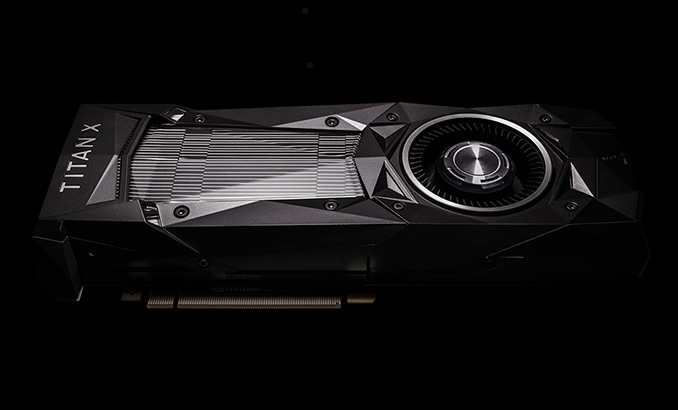
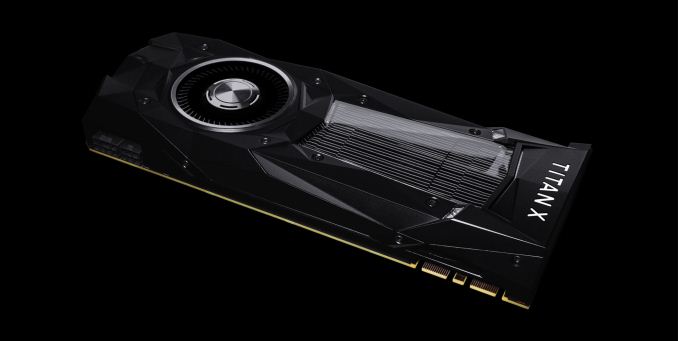


 Quote
Quote
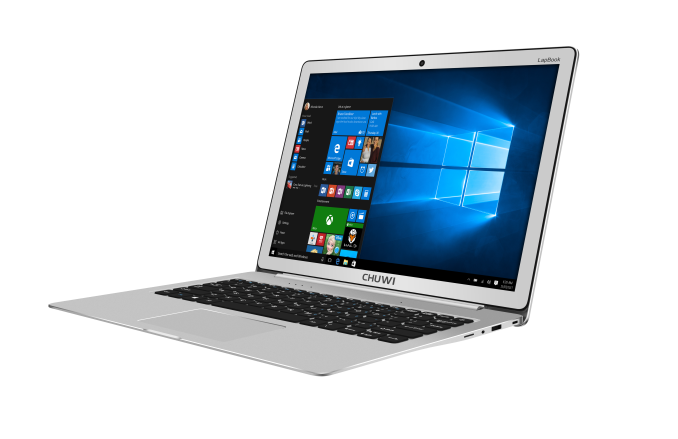
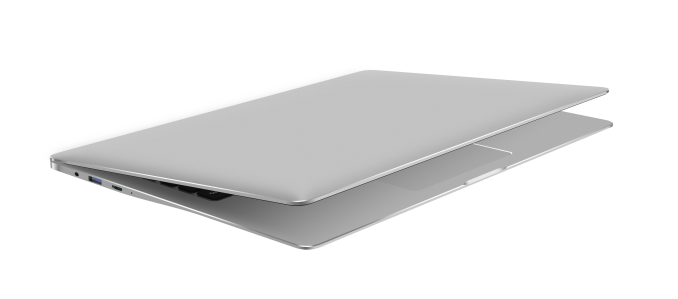
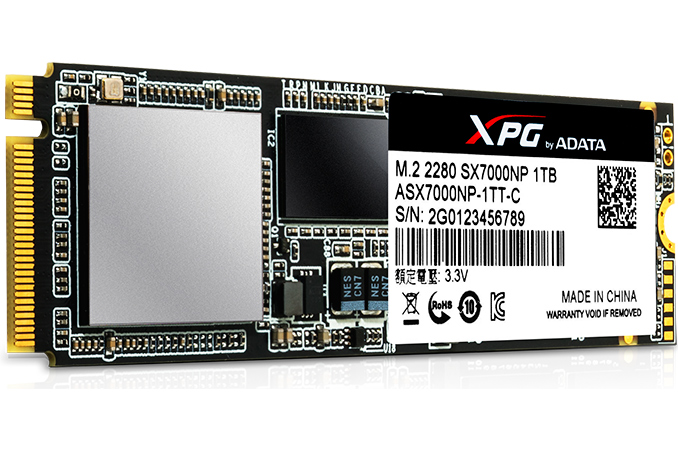

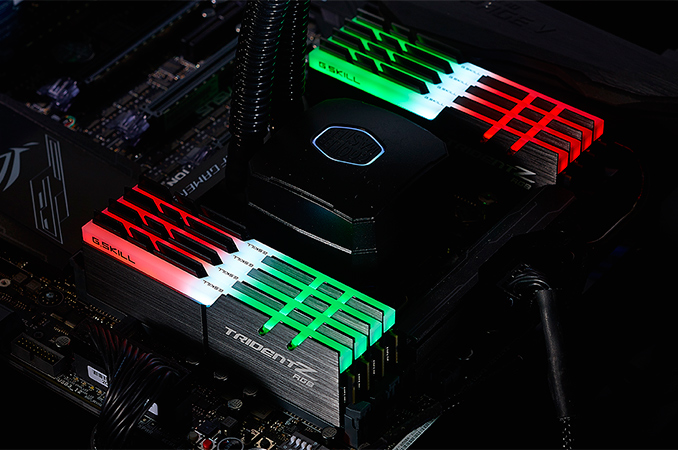
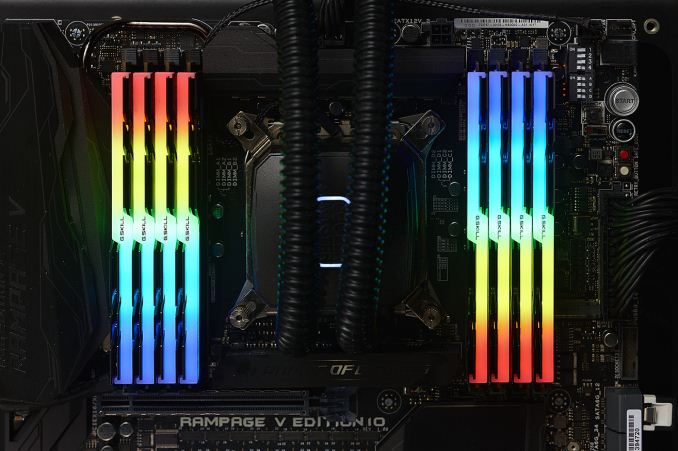
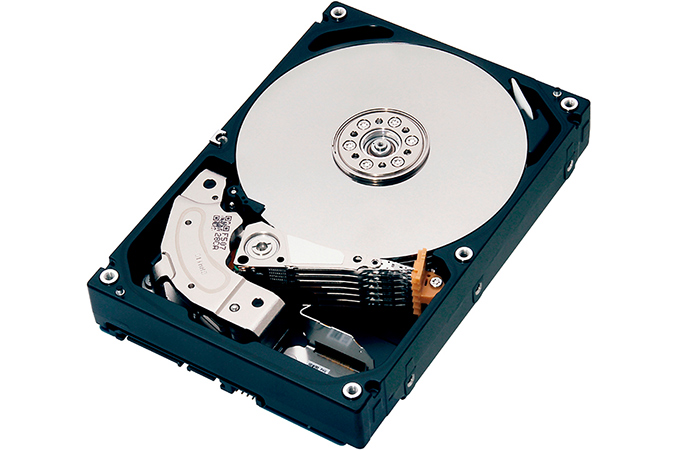


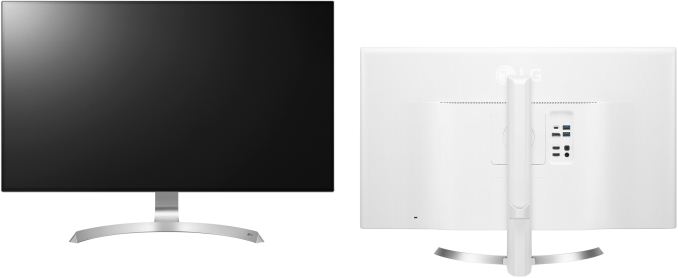
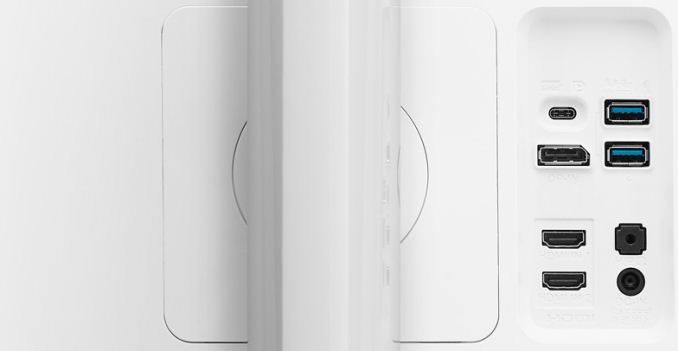
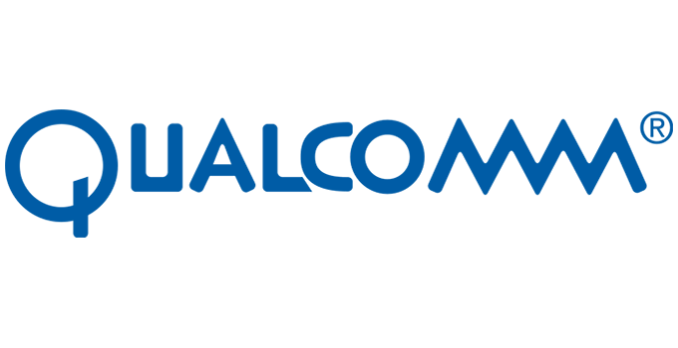

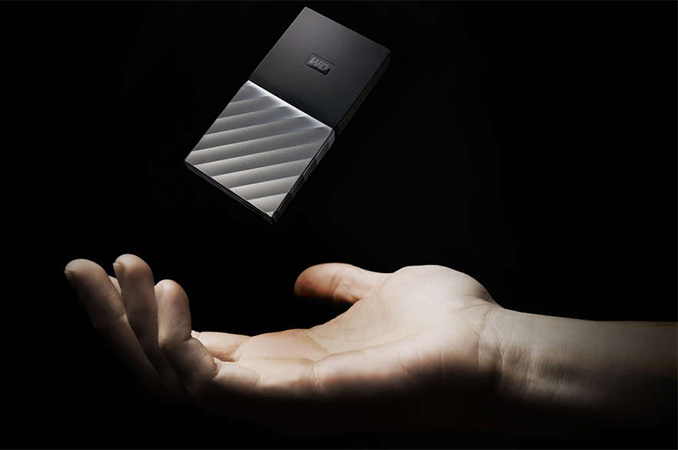

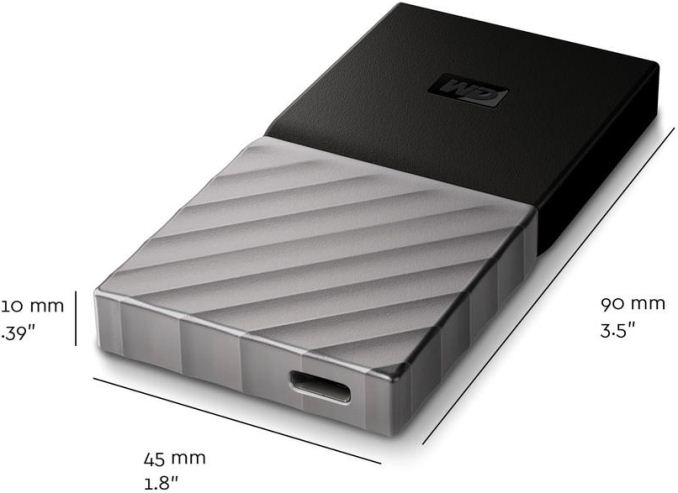
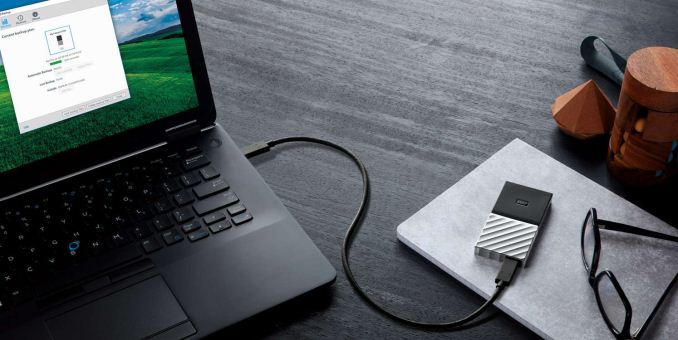
















Bookmarks